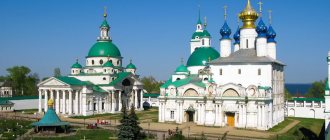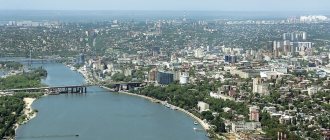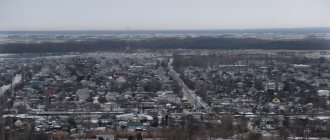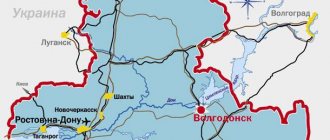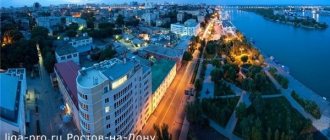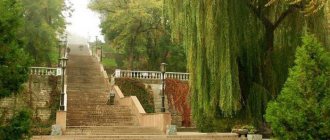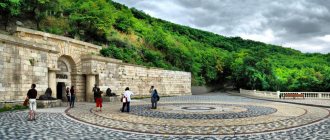269 years have passed since the founding of Rostov-on-Don. Is this a lot or not enough for the birth, development and transformation of the city? Perhaps, on the scale of world history, two and a half centuries are a grain of sand in the vast cosmos.
Or maybe this is quite enough so that, having survived many events, wars, destruction, the city can be reborn, becoming even more beautiful. From the first year of its foundation, Rostov-on-Don, relying on its internal resources, primarily human, became a leader, entering the top ten cities in Russia in terms of economic development.
“Gateway to the Caucasus” or “Port of Five Seas”
Cliche expressions that are often used to describe this city absolutely accurately reflect its location, which is ideal for economic development. The intersection of land and water roads and favorable natural conditions have made it possible, from the founding of Rostov-on-Don to the present day, for the city to be in the midst of historical events and the economic growth of the state.
If at the dawn of its birth the city was a trading and merchant city, today it is the largest industrial center of the Azov region. If in the pre-revolutionary period it was possible to go through the Rostov port to the Azov and Black Seas, which is already a lot, then after the construction of the Volga-Don Canal Rostov conquered three more seas: the Caspian, White and Baltic.
The presence of a large transport hub, water and rail, aviation and road, contributed to the development of the city. All this came later. But the location, which was successful in many respects, was already noted in its distant past.
Map
| Rostov-on-Don: maps |
Rostov-on-Don: photo from space (Google Maps) Rostov-on-Don: photo from space (Microsoft Virtual Earth)
| Rostov-on-Don. Nearest cities. Distances in km. on the map (in brackets along roads) + direction. Using the hyperlink in the distance , you can get the route (information courtesy of the AutoTransInfo website) | |||
| 1 | Bataysk | 11 (12) | YU |
| 2 | Aksai | 11 (17) | IN |
| 3 | Olginskaya | 18 () | IN |
| 4 | Chaltyr | 18 (16) | Z |
| 5 | Dawn | 19 () | NE |
| 6 | Kuleshovka | 21 () | SW |
| 7 | Azov | 27 (25) | SW |
| 8 | Samara | 33 (35) | YU |
| 9 | Kagalnik | 34 (33) | SW |
| 10 | Novocherkassk | 35 (46) | NE |
| 11 | Novobataysk | 37 (46) | YU |
| 12 | Krivyanskaya | 38 () | NE |
| 13 | Kirovskaya | 38 (34) | SE |
| 14 | Rodionovo-Nesvetaiskaya | 41 (48) | WITH |
| 15 | Persianovsky | 43 (56) | NE |
| 16 | Cossack Camps | 47 () | NE |
| 17 | Kagalnitskaya | 50 (50) | SE |
| 18 | Bagaevskaya | 51 (77) | IN |
| 19 | Taganrog | 60 (67) | Z |
| 20 | Quarries | 60 (76) | NE |
| 21 | Novoshakhtinsk | 61 (75) | WITH |
| 22 | Zernograd | 61 (76) | SE |
| 23 | Pokrovskoye | 64 (71) | Z |
| 24 | Mines | 64 (80) | NE |
| 25 | Nikolaevka | 66 () | Z |
| 26 | Matveev Kurgan | 73 (92) | NW |
| 27 | Kushchevskaya (Krasnodar region) | 74 (79) | YU |
| 28 | Mechetinskaya | 75 (94) | SE |
| 29 | Red Sulin | 76 (97) | WITH |
| 30 | Funny | 78 () | IN |
a brief description of
Located in the southeast of the East European Plain, on the right bank of the Don, 46 km from its confluence with the Sea of Azov, 1226 km southeast of Moscow.
A major transport hub is the “Gateway of the Caucasus”. Railway junction lines and highways. Sea and river port.
The climate is moderate continental. Winter is mild. The average January temperature is -7. Summer is warm and long, with predominantly sunny weather. The average temperature in July is +23. Precipitation is about 500 mm per year.
Rostov-on-Don is a large industrial, cultural and scientific center of southern Russia.
Territory (sq. km): 349
Information about the city of Rostov-on-Don on the Russian Wikipedia site
Historical sketch
December 15 (26), 1749 on the river. Don, above the place where the river flows into it. Temernik, near the Bogaty Kolodez tract, by decree of Empress Elizabeth Petrovna, the Temernitsk border customs and port were founded.
In 1761, construction began on the fortress, named after St. Dmitry (1651-1709), Metropolitan of Rostov, canonized in 1757.
At the end of the 18th century. With the annexation of the Black Sea region to Russia, the fortress lost its strategic importance. The settlement under her was transformed into a city in 1797. In 1806 its name Rostov-on-Don was officially approved.
Since 1797, Rostov-on-Don has been a district city of Novorossiysk, since 1802 - of Yekaterinoslav province.
In 1856, in the district city of Rostov-on-Don, Ekaterinoslav province, there were 10 churches, 1,792 houses, 285 shops.
Since 1887, as part of the Don Army Region (since 1888, district center).
In the first half of the 19th century. Rostov-on-Don is a large trading city in southern Russia. From the middle of the 19th century. the city also became a large industrial center and an important transport hub in the south of Russia.
In 1846, an iron foundry (now a shipbuilding and ship repair plant) was built, and in 1853 a tobacco factory was built. In 1859, a machine-building plant began operating, producing steam schooners, steam boilers, pumps, and in 1870, a paper mill. In 1896, a power station was built in the city.
In 1870, Rostov-on-Don was connected by railway with Kharkov, in 1871 with Voronezh, in 1875 with Vladikavkaz.
In 1898, an agricultural machinery plant (now a cultivator plant) was built. By the beginning of the 20th century. There were about 140 industrial enterprises in Rostov-on-Don. The Rostov port in terms of cargo turnover (mainly the export of grain, iron, timber) occupied one of the first places in the south of the country. During the navigation period, over 15 thousand workers were employed here.
In 1929, the city of Nakhichevan-on-Don (28.4 thousand inhabitants, 1897), founded in 1778 by Crimean Armenians resettled here by decree of Catherine II, became part of the boundaries of Rostov-on-Don; viceroyalty.
During the Civil War, power in Rostov-on-Don changed several times, and there were fierce battles. In December 1917, the city was taken by the troops of General A.M. Kaledina. From March to May 1918, Rostov-on-Don was the center of the Don Soviet Republic. At the beginning of May 1918, German occupation troops entered the city, then the troops of General A.I. Denikin. In January 1920, units of the 1st Cavalry Army entered Rostov-on-Don.
Since 1924, Rostov-on-Don has been the center of the North Caucasus region, since 1934 - the Azov-Black Sea region, and since 1937 - the Rostov region.
In the 1920-30s. in Rostov-on-Don, old industrial enterprises were reconstructed and expanded, new ones were created: a chemical plant (built in 1924-25), (1926-31), etc. In the 1920s. The country's first thermal power plant was put into operation.
During the Great Patriotic War of 1941-45, the region of Rostov-on-Don and the city itself were places of fierce battles; the city was occupied by Nazi troops twice: from November 21 to 29, 1941 and from July 24, 1942 to February 14, 1943 The city was finally liberated by the troops of the Southern Front during the Rostov operation.
In 1962, the village of Aleksandrovskaya, Aksai district (8.0 thousand inhabitants, 1939; 12.7 thousand inhabitants, 1959) entered the city boundaries.
[What’s wrong with the workers’ settlement of Nizhnegnilovsky, urban settlement since 1938, 7.3 thousand inhabitants, 1939; Gnilovskaya village - 5.0 thousand inhabitants, 1897]
Municipal indicators
| Index | 1990 | 1999 | 2001 | 2003 | 2005 |
| Demography | |||||
| Number of births, per 1000 population | 11.2 | 6.7 | 7.6 | 8 | 8.5 |
| Number of deaths, per 1000 population | 11.9 | 13.4 | 14.8 | 14.2 | 13.6 |
| Natural increase (decrease), per 1000 population | -0.7 | -6.7 | -7.2 | -6.2 | -5.1 |
| Standard of living of the population and social sphere | |||||
| Average monthly nominal accrued wages, rub. | 0.284 | 1207.9 | 2700.8 | 4978.2 | 7709.2 |
| Average housing area per inhabitant (at the end of the year), sq.m. | 15.2 | 18.8 | 19.4 | 18.8 | 19.9 |
| Number of preschool institutions, pcs. | 331 | 181 | 177 | 175 | 174 |
| Number of children in preschool institutions, thousand people | 48 | 21 | 22 | 22.9 | 23.9 |
| Enrollment of children in preschool educational institutions (at the end of the year), as a percentage of the number of children of the corresponding age, % | 51.7 | 53.3 | |||
| Number of daytime educational institutions (at the beginning of the school year), pcs. | 110 | 155 | 160 | 159 | 157 |
| Number of students in daytime educational institutions, thousand people | 114.6 | 120.9 | 112.3 | 100.9 | 90.9 |
| Number of doctors, people. | 6739 | 7515 | 7464 | 7721 | 7800 |
| Number of nursing staff, people. | 10829 | 11662 | 10961 | 11205 | 11088 |
| Number of hospital institutions, pcs. | 38 | 41 | 41 | 41 | 41 |
| Number of hospital beds, thousand units | 12.2 | 12.3 | 12.9 | 12.8 | 13.5 |
| Number of medical outpatient clinics, pcs. | 81 | 118 | 97 | 103 | 99 |
| Capacity of medical outpatient clinics, visits per shift, thousand units. | 24.6 | 30.4 | 29.8 | 30.1 | 27 |
| Number of registered crimes, pcs. | 21138 | 20417 | 20121 | 25256 | |
| Persons who committed crimes were identified, persons. | 9183 | 7600 | 6695 | 6136 | |
| Economy, industry | |||||
| Number of enterprises and organizations (at the end of the year), pcs. | 36425 | 45950 | 102793 | 50354 | |
| Number of operating enterprises by type of activity: mining (at the end of the year), pcs. | 0 | ||||
| Number of operating enterprises by type of activity: manufacturing (at the end of the year), pcs. | 435 | ||||
| Number of operating enterprises by type of activity production and distribution of electricity, gas and water (at the end of the year), pcs. | 82 | ||||
| Volume of shipped goods of own production by type of mining (in actual prices), million rubles. | 0 | ||||
| Volume of shipped goods of own production by type of manufacturing (in actual prices), million rubles. | 68255.9 | ||||
| Volume of shipped goods of own production by type of production and distribution of electricity, gas and water (in actual current prices), million rubles. | 15174.6 | ||||
| Construction | |||||
| Volume of work performed by type of activity “Construction” (until 2004 - volume of work performed under construction contracts), million rubles. | 2669 | 5297 | 8371.5 | 15987.4 | |
| Commissioning of residential buildings, thousand sq.m. of total area | 304.7 | 410.7 | 427.2 | 505.8 | 620.1 |
| Commissioning of residential buildings, apartments | 5572 | 4512 | 4817 | 6039 | 7647 |
| Commissioning of preschool institutions, places | 0 | 0 | 0 | 0 | 0 |
| Commissioning of educational institutions, places | 1176 | 0 | 975 | 1215 | 0 |
| Commissioning of hospital facilities, beds | 0 | 0 | 81 | 707 | 10 |
| Commissioning of outpatient clinics, visits per shift | 650 | 0 | 600 | 880 | |
| Transport | |||||
| Number of bus routes (in intracity traffic), pcs. | 88 | 64 | 107 | 131 | |
| Number of tram routes, pcs. | 5 | 6 | 5 | 6 | |
| Length of operational tram tracks (at the end of the year), km | 53.5 | 49.6 | 44 | ||
| Number of trolleybus routes, pcs. | 11 | 11 | 10 | 8 | |
| Length of operational trolleybus lines (at the end of the year), km | 115 | 118.9 | 107.4 | ||
| Number of passengers transported by buses per year (in intracity traffic), million people. | 169.9 | 148.6 | 115.7 | 146 | 153.4 |
| Number of passengers transported by trams per year, million people. | 78.8 | 57.9 | 30.6 | 18.1 | 13.1 |
| Number of passengers transported by trolleybuses per year, million people. | 108.2 | 64.7 | 33.6 | 26.1 | 17.3 |
| Connection | |||||
| Number of telephone sets of the city public telephone network, thousand units. | 143.2 | 245.1 | 249.4 | 265.5 | 285.5 |
| Number of residential telephone sets of the city public telephone network, thousand units. | 114.4 | 196.2 | 201 | 214.5 | 227.7 |
| Number of payphones of the city telephone network (including universal ones), pcs. | 3050 | 1635 | |||
| Trade and services to the population | |||||
| Retail trade turnover (in actual prices), million rubles. | 19841 | 35803 | 59238 | 99921.1 | |
| Retail trade turnover (in actual prices), per capita, rub. | 19548 | 35571 | 55628 | 94586.5 | |
| Index of physical volume of retail trade turnover, % compared to the previous year | 112.7 | 118.4 | |||
| Index of physical volume of public catering turnover, % compared to the previous year | 108.1 | 118.4 | |||
| Number of stores, pavilions (at the end of the year), pcs. | 411 | 497 | |||
| Sales area of shops, pavilions (at the end of the year), sq.m. | 72027 | 110497 | |||
| Volume of paid services to the population (in actual prices), million rubles. | 0.358 | 4399 | 8470 | 17193.7 | 28154.5 |
| Volume of paid services to the population (in actual prices), per capita, rub. | 0.4 | 4334 | 8415 | 16145.9 | 26651.3 |
| Volume of household services to the population (in actual prices), million rubles. | 0.077 | 1229 | 1971 | 3352.1 | 5050.3 |
| Volume of household services to the population (in actual prices), per capita, rub. | 0.08 | 1211 | 1959 | 3147.8 | 4780.6 |
| Investments | |||||
| Investments in fixed assets (in actual prices), million rubles. | 0.4 | 2920 | 12671 | 16780.3 | 24473.2 |
| Share of investments in fixed assets financed from budgetary funds in the total volume of investments, % | 16.8 | 22.1 | 26.4 | 28.7 | |
Data sources:
- Regions of Russia. Main characteristics of the constituent entities of the Russian Federation: statistical collection. Goskomstat of Russia. - M:, 2003.
- Regions of Russia. Basic socio-economic indicators of cities. Statistical collection. Rosstat. - M:, 2005. p. 197
- Transport in Russia: Statistical collection. Goskomstat. - M:, 2003. pp. 110, 112, 120, 122
- Transport in Russia: Statistical collection. Rosstat. - M:, 2005. pp. 117, 119, 127, 129
- Regions of Russia. Basic socio-economic indicators of cities. 2006. Statistical collection. Rosstat. - M:, 2006. p. 197
Culture, science, education
The North Caucasus Scientific Center of Higher Education is located in Rostov-on-Don: research institutes of biology, neurocybernetics, physical and organic chemistry, mechanics and applied mathematics, hydrochemistry. Research Institute of Radiology, Oncology, etc.
About 40 design and engineering institutes, incl. institutes for the design of combine industry plants, power engineering plants, oil refining and petrochemical industries.
Rostov State University. Rostov Technical University. Academy of Construction. Medical Academy.
Institutes: Azov-Black Sea agricultural mechanization, architectural, railway transport engineers, national economy, automation and mechanical engineering technology, music and pedagogical, pedagogical.
VTUZ at . Faculty of the Nizhny Novgorod Institute of Water Transport Engineers. Branches: Moscow Civil Aviation Engineers, Moscow Commercial University, Moscow Correspondence Institute of Food Industry.
Theatres: drama named after M. Gorky, young spectators, musical comedy, puppets. Circus.
Museums: regional local history, fine arts (collection of Russian art).
In 1777 and 1783-84. A.V. lived in the house of the commandant of the Rostov fortress. Suvorov, who was then the commander of the Kuban Corps.
Museums, galleries, exhibition halls
Gallery of children's art 344000, Rostov region, Rostov-on-Don, st.
Chekhova, 60 Phone(s): (8632) 65-4126 Natural Science Museum of Innovation 344092, Rostov region, Rostov-on-Don, st. Sorge, 7, Faculty of Chemistry, Southern Federal University Phone(s) Website: https://www.museion.ru/
Museum of Russian-Armenian Friendship 344113, Rostov region, Rostov-on-Don, st. Bagramyan, 1 Phone(s): (8632) 76-4180
Museum of Contemporary Fine Arts on Dmitrovskaya 344002, Rostov region, Rostov-on-Don, st. Bolshaya Sadovaya, 64/51 (Shaumyan St.) Phone(s) Website: https://www.museum-nd.ru/
Rostov Museum of Cosmonautics 344091, Rostov region, Rostov-on-Don, Stachki Ave., 231/2 Telephone(s): enquiry; ex.bureau Website: https://www.nppkpkvant.ru/vertikal/museum/
Rostov Regional Museum of Fine Arts 344007, Rostov region, Rostov-on-Don, st. Pushkinskaya, 115 Phone(s): (863) 201-3982 240-2907 Website: https://www.romii.ru/
Rostov Regional Museum of Local History 344006, Rostov region, Rostov-on-Don, st. Bolshaya Sadovaya, 79 Telephone(s); 240-52-13 Website: https://www.rostovmuseum.ru/
Architecture, sights
The historical structure of the city consisted of three parts: the former fortress of St. Demetrius, which had a star-shaped plan with 9 rays-redoubts (disbanded in 1835) and its two suburbs - Rostov proper and Nakhichevan. The modern center unites all these three parts.
The rectangular grid of streets was formed according to the master plans of 1811 for Rostov-on-Don and Nakhichevan; the city retained its characteristic southern Russian buildings.
Cathedral (1780s). Buildings so-called City house (1896-99, architect A.N. Pomerantsev), city theater (1896, architect A.B. Lyubimov), State Bank (1910, architect M.M. Peretyatkovich), Volga-Kama Bank (1900, architect A.N. Beketov), Pedagogical Institute (1912, architect I.A. Cherkesian), etc.
In the 1920-30s. Residential settlements for tram drivers (1924), water workers (1926), Novy Byt (1928), Gigant-I and Gigant-II (1930-31) were built. House of Soviets (1929-34, architect I.A. Golosov), Theater named after. M. Gorky (1930-35, architect V.A. Shchuko, V.G. Gelfreich).
The city was heavily destroyed during the Great Patriotic War and rebuilt in the 1940-50s.
At the mouth of the river Don - excavations of the ruins of the ancient city of Tanais (3rd century BC - 5th century AD), which was part of the Bosporan state.
| Population by year (thousands of inhabitants) | |||||||
| 1811 | 4.0 | 1956 | 552 | 1992 | 1027.1 | 2011 | 1089.3 |
| 1840 | 12.6 | 1959 | 599.5 | 1996 | 1024.5 | 2012 | 1096.4 |
| 1856 | 12.6 | 1962 | 661 | 1998 | 1020.0 | 2013 | 1103.7 |
| 1863 | 29.3 | 1967 | 757 | 2000 | 1012.7 | 2014 | 1109.8 |
| 1897 | 119.5 | 1970 | 788.8 | 2001 | 1009.0 | 2015 | 1114.8 |
| 1914 | 172.3 | 1973 | 845 | 2003 | 1068.3 | 2016 | 1119.9 |
| 1923 | 231.4 | 1976 | 898 | 2005 | 1058.0 | 2017 | 1125.3 |
| 1926 | 299.7 | 1979 | 934.1 | 2006 | 1054.9 | 2018 | 1130.3 |
| 1931 | 425.1 | 1982 | 966 | 2007 | 1051.6 | 2019 | 1133.3 |
| 1934 | 455.0 | 1986 | 992 | 2008 | 1048.7 | 2020 | 1137.9 |
| 1939 | 502.9 | 1989 | 1019.3 | 2010 | 1048.1 | 2021 | 1137.7 |
Foundation of Rostov-on-Don
The history of every city begins with a legend, and Rostov-on-Don is no exception. In 1695, young Peter I, marching with his army to Azov, found himself in these deserted places. The king dismounted and drank water from the spring. “Rich well!” he concluded. These words were enough for the place to be called that. The Tsar then thought that if a fortress was to be built to protect the Russian lands from the enemy, it would only be here, in this strategically advantageous place. But the founding of the city of Rostov-on-Don never took place that year. His time has not yet come.
The fortress appeared here 50 years later. Elizaveta Petrovna, daughter of Peter I, chose a place near the “Rich Well” for the construction of a border customs house. The Russian state needed a service in the south of the country to collect duties from local and foreign traders. It was also necessary to stop the transportation of contraband goods.
On December 15, 1749, the Empress signed a decree on the creation of the Temernitsk customs house, located near the historical well, and two miles from the Temernik River. This day is officially considered the founding day of Rostov-on-Don. A little later, a fortress appeared to guard it. Elizaveta Petrovna gave her the name of Metropolitan Dimitry of Rostov, who was canonized shortly before these events.
Over time, the name of the fortress was shortened to Rostov, and even later, to avoid confusion with the northern city, a geographical clarification was added. This is how the city of Rostov-on-Don appeared on the map of Russia.
The fortress did not last long since the founding of Rostov-on-Don. Due to the end of the Russian-Turkish wars, it lost its significance as a military structure, but its role as an intermediate port between Taganrog and Central Russia increased.
Historical and outstanding buildings and structures
Rostov has many beautiful residential and public buildings. These include:
- The City Council building, created by the architect A. N. Pomerantsev in the eclectic style.
- Masalitina's apartment building on Bolshaya Sadovaya Street.
- Chernova's house, where a large bank is currently located.
- The modern business center 5 seas, created by famous architects S. Choban, S. Kuznetsov, V. Shalyavsky, M. Dahlmann, with its unique shape repeats the configuration of an unopened shell.
- The Cathedral of the Nativity of the Blessed Virgin Mary, architect K. A. Ton, is truly the visiting card of the city.
- Unique Rostov Academic Theater named after. M. Gorky, repeating in its form the Kommunar tracked tractor, as a symbol of the conquest of the virgin expanses of the steppes during the period of industrialization of the country.
- The grandiose (more than 37,000 m2) building of the Rostov State Musical Theater resembles in its shape a grand piano with an open lid. This idea and its implementation, the project of a pompous theater construction, were carried out by architects L. Lobak, G. Dukov, V. Khafizov. There is no such unique structure anywhere in the world. Finished in white natural marble, it truly inspires respect for art and music.
Many architectural monuments were lost during the Great Patriotic War, but to this day the city has something to show its guests.
Founding of Nakhchivan
After the founding of Rostov-on-Don, Empress Catherine II pursued a foreign policy aimed at weakening the Crimean Khanate, which was under Turkish control at the time. To achieve this, in 1779 she allowed the resettlement of Armenians from the peninsula to the lower reaches of the Don. In addition to weakening the economy of Crimea, Russia received on its territory a hardworking, Orthodox people capable of accelerating the development of the region.
12 thousand immigrants founded the city of Nakhichevan near Rostov, and the two peoples lived for many years in peace and harmony. By the beginning of the 20th century, the border between the cities was completely erased.
Development of the city in the pre-revolutionary period
Meanwhile, the development of the city continued at an enviable pace. There is another important date in the history of the founding of Rostov-on-Don. In 1807, by decree of Alexander I, it received city status. On its coat of arms, a fortress tower is depicted as a symbol of past years.
After the construction of the new customs house, trade turnover increases 30 times, which allows for a sharp jump in economic development. The city begins to build industrial enterprises. The beginning was laid by an iron foundry, which was put into operation in 1846. And after four years, 53 heavy and light industry enterprises operated in the city. All this contributed to population growth. From 3 thousand in 1809 it increased to 13 thousand in 1856.
In the middle of the 19th century, the first water supply system appeared in the city, then the first telephones, and at the end of the century - electric lighting. Trams went through the streets. There have also been positive changes in the education sector. One of the universities was evacuated from Warsaw to the city. Sports, culture and art were not left out. Thus, pre-revolutionary Rostov-on-Don was one of the progressive and prosperous cities of Russia.
Attractions
In addition to the already mentioned unique buildings of the theaters of musical comedy and drama, repeating the shape of a piano and a tractor, there are other places of interest in the southern capital.
- Ceramic frescoes depicting the history of Russia. They decorate the walls of underground passages in the city.
- Embankment of the river The Don is truly the decoration of the entire city, a favorite place for walks and jogging for citizens. All the most beautiful buildings in the city tend to open their façade to the river and the left bank.
- Levberdon is the abbreviated name for a recreation area on the left bank of the Don, where, in addition to concentrating a huge number of restaurants and parks in the lap of nature, it is planned to host the World Cup stage in 2022. It is there that a stadium with 45,000 seats is being built.
- The zoo, which occupies about 100 hectares, where you can see thousands of flora and fauna, contains the largest number of great apes of all species in Russia.
- Drawbridge across the river. Don has a history of more than 100 years. The unique design of the middle span allows ships to quickly pass along the river fairway in both directions.
- Among the monuments, Tachanka can be noted as most accurately characterizing and reflecting a huge time layer in the history of the city. It is the Tachanka-Rostovite metal sculpture that has been greeting Rostovites and guests of the city for several decades. This historical monument, which was intended to symbolize the liberation of the city from the White Guards, was loved by residents and became the hallmark of the city at all its representative offices.
Rostov-on-Don and the revolution
In the first years of the revolution, the city found itself at the epicenter of battles. The events of the Civil War affected every family. The political views of local residents were divided into diametrically opposed ones. But the majority did not support the revolution, and all the forces of the city were aimed at helping the White movement.
The areas controlled by the Don Army, which opposed the Bolshevik regime, found themselves involved in a confrontation between the two forces. A separate Rostov regiment was formed from the city’s youth who joined the Volunteer Army.
At the same time, in early April, the congress of Soviets of workers and Cossack deputies of the Don Republic takes place in the city. He recognizes the power of the Soviets, the Brest Peace Treaty and begins to nationalize enterprises. But already on April 25, the Don Republic ceased to exist, and the city was occupied by Ataman Krasnov.
Over the course of two years, power changed hands, with either the Reds or the Whites winning. People died, families and foundations collapsed, the economy went bankrupt. In March 1920, Soviet power was finally established.
Soviet city
Rostov, which so actively did not want Soviet power, quickly began to pick up the pace of economic growth, and therefore prosperity. In the mid-20s, construction began on Rostselmash, a giant and leader of the domestic industry. A breakthrough was also made in the field of theatrical art: a theater building was built in the city. The names of the actors who worked here are known to the older generation: Yu. A. Zavadsky, V. P. Maretskaya, R. Ya. Plyatt.
In the fall of 1941, Rostov was occupied by German troops. A week later they were driven out by the army of S.K. Timoshenko. In July 1942, the city was again surrendered to the Nazis. Final liberation came in February 1943. During this time, German soldiers killed 40 thousand people, 53 thousand were forcibly taken to Germany. The city was almost completely destroyed; it was one of the ten most affected by the war.
Post-war Rostov
The city, which survived the horror of occupation, began to quickly recover. People worked selflessly, missing simple, peaceful work. Trams were quickly launched and restoration of Rostselmash began. Already in 1947, the first combine harvester “Stalinets 6” came out of the gate. The city's enterprises began to operate: a steam locomotive repair plant, a tobacco factory and others.
Rostov was included in the list of cities to be restored first. This work was carried out by 36 specialized organizations. During the period from 1948 to 1951, 378 buildings were restored and built, of which 228 were residential. Changes were also taking place on the Don. In 1952, the Volga-Don Canal began operating, and in 1965, traffic was launched on the Voroshilovsky Bridge. Educational institutions, cultural institutions, and monuments were opened. In 1987, the city became a million-plus city.
Automobile transport
The following highways pass through Rostov or in its immediate vicinity:
- M4 "Don" is the largest federal highway, entering Rostov from the south along the access road A135. Connects the city with Moscow, Voronezh, Krasnodar and Novorossiysk.
- A280 (formerly M23) is a federal highway from Taganrog to the Ukrainian border.
The M4 Don highway, in turn, is part of the European routes E115 (Yaroslavl - Novorossiysk), E97 (Kherson - Ashkala), E50 (Brest - Makhachkala), E38 (Glukhov - Shymkent), etc.
270th anniversary of Rostov-on-Don
In 2022 it will be 270 years since the founding of the city of Rostov-on-Don.
Today it is the largest southern city, a city of military glory. It is an industrial, cultural, educational and scientific center, as well as an important transport hub for the southern regions. Rostov is a multinational and multi-religious city, in which people of different nationalities and religions have lived in harmony and without conflicts for centuries. The city has many jobs in various sectors of industry, education and the arts.
There is a lot of construction going on here now. In recent years, a lot of work has been done to restore old buildings, improve streets and parks, and housing problems are being solved. Rostov is a city of educational institutions, libraries, theaters and concert halls. In recent years, the tourism industry has been developing well: new hotels are being built and old ones are being improved. Sights are being restored, house facades are being put in order. The city has become very beautiful and interesting.
Cost of new buildings
The cost of new buildings in Rostov depends, as elsewhere, on a number of factors, but varies on average from 40,000 to 200,000 rubles/m2 of the total area of the apartment. Of course, the cost per square meter in the suburbs and region is much lower. Thus, according to the Housing Mortgage Lending Agency, the average cost of housing for the Rostov region in the summer of 2022 was 55,000 rubles/m2;.
The cost of new panel buildings located in insufficiently infrastructurally developed areas of the city starts from 37-38 thousand rubles/m2; total area. The price for new buildings in luxury apartments located in prestigious areas of the city can easily reach 180,000 rubles/m2; Yes, such is the range of real estate prices in the southern capital.
The average price in a reasonable area, not too far from the center, will be 60,000-80,000 rubles/m2;.
The full catalog of new buildings in Rostov-on-Don with prices, reviews and ratings can be viewed on our website
